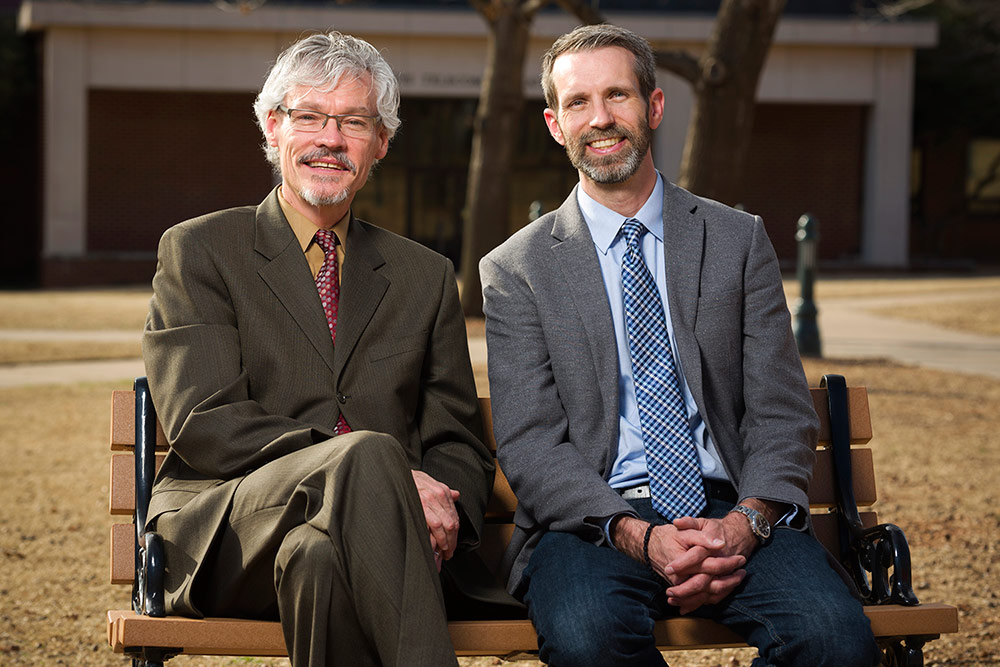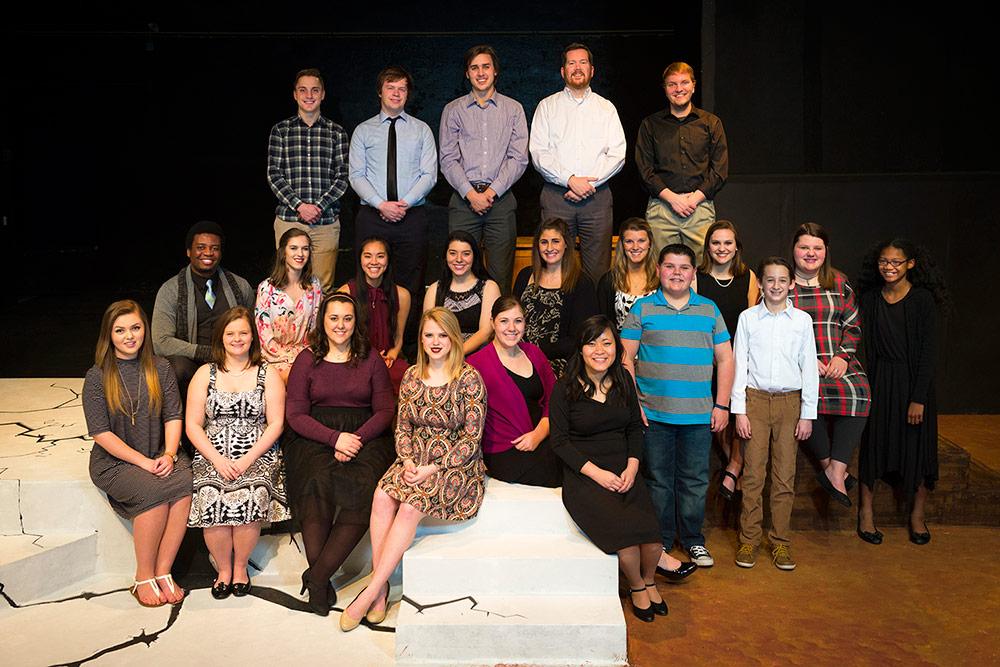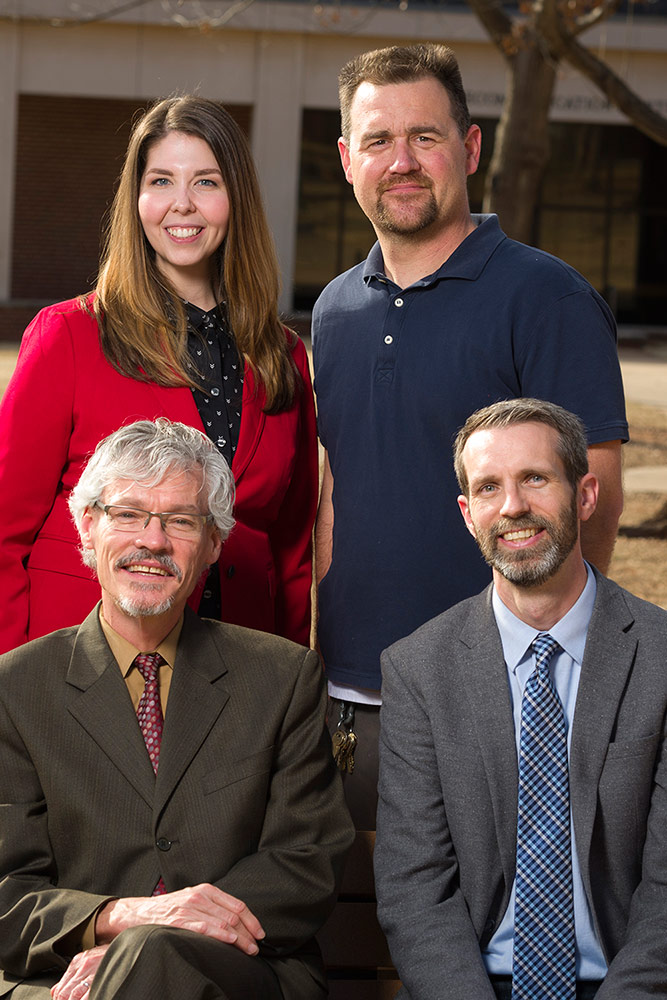Vernon and Newsom’s Opera “A Porcelain Doll” to Premiere March 3-5
February 14, 2017
Dr. James Vernon, professor of music at Oklahoma Baptist University, has long yearned to compose an opera. Yet, before he could undertake such a project, he would need to find inspiration for a fitting story, time to complete the score, and the right partner with whom to collaborate on the writing of the story for the opera.
Determined to see his dream through, he began searching for a topic in 2013. As director of the Bisonettes [women’s glee club at OBU], he wanted to find a strong female role model as the subject for the work. He also wanted to write a truly American opera in English. As he was searching online, one name, previously unknown to him, continued to come up. The more he read, the more intrigued he became.
Thus began Vernon’s journey to composing “A Porcelain Doll,” the moving story of the life of Laura Bridgman (1829-89), the first deaf-blind student to successfully learn to communicate with others. Born in Hanover, New Hampshire, she lost her sight, hearing, and most of her sense of taste at the age of two due to scarlet fever. Over the course of her life, she overcame all odds to learn, thrive, and prosper, ultimately becoming one of the most famous women in the world.
The opera debuts in its world premiere March 3-5 in the Craig Dorland Theater on the campus of OBU in Shawnee. Performances are March 3 and 4 at 7:30 p.m. and March 5 at 2:30 p.m. Tickets are $13 for adults and $5 for students and may be purchased at www.okbu.edu/opera.
Audience members are encouraged to attend a preshow lecture before each performance, featuring background information and details about Bridgman’s life, her learning process, and insights into the production. These sessions begin at 6:45 p.m. on March 3 and 4, and at 1:45 p.m. March 5. The pre-show lectures will take place in a large classroom across the hall from the theater entrance in Shawnee Hall. A 10-minute talk-back session will follow each performance.
With a topic chosen and the inspiration to compose in hand, Vernon needed someone to collaborate with on writing the story, or libretto, of the opera. He turned to friend and colleague Dr. Brent Newsom, assistant professor of English, approaching him about the project more than two years ago.
“We go to church together and I'm a big fan of his poetry,” Vernon said. “It turns out, he [Newsom] had always wanted to write a libretto for an opera.” So, the two began collaborating, working on a few scenes at a time as they worked their way through the story.
Newsom was grateful to Vernon for the opportunity.
“Writing the libretto took longer than I expected, partly because of the research required and partly because it took some time to figure out how it should be structured. Thankfully, Dr. Vernon was a very patient collaborator,” Newsom said.
Vernon was granted a half-load sabbatical during the 2015-16 academic year, using that time to work diligently on “A Porcelain Doll.” He locked himself away in a cabin in Arkansas for a week during October 2015, and continued the composition process through July 2016.
“Tuesdays and Thursdays it was my full-time job,” Vernon said. “I would write for 8 to 10 hours per day. The writing was the easy part, but the formatting was tedious. The composing is the fun part.”
The work is a full-scale stage opera detailing Bridgman’s life, the first deaf-blind person to gain a significant education in the English language through the efforts of the Perkins School of the Blind in Boston, Massachusetts. The opera deals with significant experiences in her life, including the realization of language, life as a significant celebrity in the mid-19th century, visits from travelling dignitaries such as Charles Dickens, the establishment of religion as a reality in her life, and her later years living in the Perkins School where she assisted with younger students and inspired others, including Anne Sullivan, the eventual teacher of the young Helen Keller, whom Bridgman also met near the end of her life when Keller was eight years old.
“In composing my first opera, I wanted the music to be a reflection of several things,” Vernon said. “First, I wanted it to reflect my compositional style and tendencies and to be true to myself as a composer. Second, I wanted the music to best reflect the texts given me in this marvelous libretto by my co-collaborator Brent Newsom. In the best possible sense, I wanted the texts to be prominent and the music to support them. Finally, I wanted the music to reflect the characters in this drama. I wanted to portray their personal and public thoughts in a manner that is accessible, yet challenging to the audience and the performers.”
Newsom took great pains to carefully tell Bridgman’s story through the libretto.
“I wanted to give a broad sense of the arc of Laura Bridgman's life. So, the most challenging aspect of writing this particular libretto was selecting which moments could best communicate her story, and then structuring the narrative in a way that would not only make sense to the audience but also heighten the drama,” Newsom said.
Vernon anticipates a powerful experience for audiences who are exposed to Laura’s moving story through the performance.
“In the end, I believe the story of Laura Bridgman, in words and in music, has been composed to give light on this remarkable woman who gives the world hope – that those with severe disabilities can achieve great things and be fully engaged partners with all society,” Vernon said. “It may be odd to some that music might be chosen as a vehicle to portray the thoughts and story of a woman who could neither speak nor hear. Yet I believe making music is one of the first things Laura Bridgman wanted to do when she was released from her earthly home and attained her heavenly one.”
Newsom concurred.
“Opera, an art form that is visual, musical, and vocal, might seem a strange choice of medium to tell the story of a woman who couldn't see, hear, or speak. But Laura loved sensing the vibrations that musical instruments emit, so I think she'd be pleased with the use of music. Also, the opera presented a chance to attempt giving her a voice in a way her body did not,” Newsom said.
To that end, Vernon composed the music to guide the audience through Laura’s emotions and created a special character to illuminate her thoughts and feelings. “Pneuma” represents the soul, spirit, and consciousness of Laura. Positioned on a balcony overlooking the stage, Pneuma gestures in synchronization with Bridgman and sings Laura’s thoughts, but does not move from her balcony.
Rebecca Ballinger, assistant professor of voice, is directing the production. She is excited to help bring this powerful story to the audience.
“‘A Porcelain Doll’ is like a physical representation of a memoir. The stage is abstracted so you see Laura's voice, Pneuma, atop the stage behind a scrim. In act one, it's more of a linear time progression, from when she started learning to her first major life event. In act two, there is some jumping back and forth in time all centering on that life event, exploring her growth more as a person than as a student.”
David Kenworthy, assistant professor of theatre and design technician, is the technical director and set designer. He created a unique set design which establishes a powerful setting for telling the story.
“The stage is setup so we can move more through Laura's mind,” Ballinger said.
The music was also composed with Laura’s deaf-blindness in mind, helping the audience enter her world through the instruments and tones selected.
“When you hear the orchestration, you will hear that Howe [Laura’s first teacher] is paired with the double reeds,” Vernon said. “Laura is paired with the flute. A lot of operas would sing a line, then repeat the line, then sing it again. In this opera, there's not a lot of repetition in the vocal parts, but there is in the instrumental parts.”
Vernon created a minimalist score, with the marimba as the most important piece in the orchestra, which also features nine strings, four woodwinds, and percussion.
Ballinger added, “It's a bit like a movie score. You might not go away humming all of the melodies, but the music is there to tell you emotionally what is going on in the show. It's there to guide you through the material, the denseness of her life.”
Newsom is eagerly anticipating the fruits of collaboration coming together in the performances.
“My prior writing experience is mainly in poetry and fiction – art forms that are solitary but that persist, so one could read and reread a poem many times, for example,” Newsom said. “In contrast, opera is an extremely collaborative enterprise, drawing on the expertise of a composer, director, set designer, musicians, the cast and crew ... so many people have devoted their talents to this project. And, because it's a live performance, opera is constrained by time and space in a way that poetry and fiction aren't. I think these qualities heighten the experience for artists and audience alike.”
Ballinger encourages everyone to experience this powerful, moving performance.
“It's a great first step in the opera. It's in English. It deals with love and self-identity, and we are able to see it in a rather unique and spectacular individual,” Ballinger said.
The cast includes McKenzie Reece as Laura Bridgman and Cassidy Olsen as Pneuma, Laura’s voice. Dr. Stephen Sims, assistant professor of music, will play Samuel Gridley Howe.
The role of Mary Swift will be played by Paige Shelton, while Jude Balthazar will portray Charles Dickens. Jennifer Watson will play Harmony Bridgman, while Julie Welch will portray Julia Ward Howe. The opera includes more than 20 roles in all, including OBU students and members of the community.
To purchase tickets, visit www.okbu.edu/opera. For more information about the production and the history behind the story, visit porcelaindollopera.wordpress.com.


